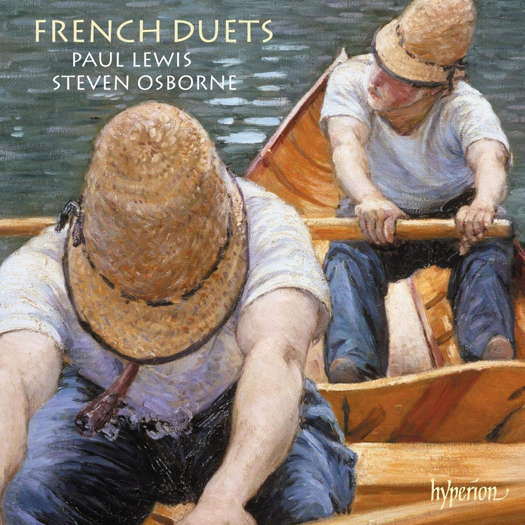- Guild Music Ltd
- Steinway Pianos
- Veracini
- Kentish Opera
- SWR Media Services GmbH
- George Frideric Handel
- Stephen Kovacevich
- City of London Sinfonia

Most Welcome
GERALD FENECH listens to French piano duets
'Paul Lewis and Steven Osborne, two of Britain's foremost pianists, give matchless performances, and their virtuosic brilliance and unique sensitivity to the many nuances of these scores are an absolute joy to listen to.'
This delightful issue of French music written for two pianos is indeed like a breath of fresh air. Our infrequent acquaintances with these miniatures are usually in their original piano duet version or in an orchestral adaptation, so this recording is most welcome, if only for the opportunity of evaluating them afresh in their proper perspective.
The Petite Suite and Six épigraphes antiques by Claude Debussy (1862-1918) are circa thirteen years apart. The Petite Suite dates probably from the end of 1888. It was printed in February 1889, and the composer and his future publisher, Jacques Durand, gave the first performance at a private salon on 1 March. It is indeed ideal salon music, nothing too heavy or too long, with easily grasped rhythms and some sweet, memorable tunes. One can detect influences of Delibes and Fauré, and in the vivacious last movement, Chabrier, but elsewhere, there is a decorous, olde-worlde air about much of the music, with its clear-cut phrases and modal inflections, as in the opening harmonies of 'En bateau' (first movement).
After setting three of his friend Pierre Louys's 1894 prose poems Les chansons de Bilitis in 1898, Debussy was again asked by Louys to provide incidental music for the mimed recitation of another twelve poems. Choosing a delicate ensemble of two flutes, two harps and a celesta, these Épigraphes antiques were first performed on 7 February 1901. After that, the score remained buried away among the composer's papers until 1914, when with Debussy finding himself in dire financial straits, he decided on turning six of them into pieces for piano duet. He asked for and received 3,000 francs, but an orchestral version never came about. As French composers of the time often did, Debussy created a pastoral vision of Ancient Greece through modal melodies and harmonies. The music is simple but colourful and there is an oriental whiff that gives it a certain delicate taste.
Listen — Debussy: Pour un tombeau sans nom (Six épigraphes antiques)
(track 11, 0:00-0:47) ℗ 2021 Hyperion Records Ltd :
In 1914, Igor Stravinsky (1882-1971), having just recovered from the turmoil of The Rite of Spring and its fall out, decided to compose a few works on a much smaller and less intense scale. Three easy pieces for piano duet were, no doubt, intended to engage and amuse his two elder children, Theodore (aged seven) and Ludmilla (aged six). Stravinsky's biographer Stephen Walsh notes the basic idea of 'modelling on a stereotype something which strongly suggests but does not in fact belong to that stereotype' - in this case, the world of the music hall and café concert that was to inspire such composers as Poulenc and Auric in the early 1920s. These three very short pieces all have a dedicatee: the 'March' to pianist and composer Alfredo Casella, the 'Waltz' to composer Eric Satie and the 'Polka' to choreographer Sergei Diaghilev.
Listen — Stravinsky: Waltz (Three easy pieces)
(track 21, 0:00-0:35) ℗ 2021 Hyperion Records Ltd :
Francis Poulenc (1899-1963) was nineteen years old when he finished his Sonata for four hands in June 1918, while he was still under the influence of Satie's Socrate and its lessons of purity, balance and reserve. The Sonata does not include the lyrical aspects that form the cornerstone of the piano duets of Fauré, Debussy or Ravel. Indeed, the outer movements are not so serene, reflecting Poulenc's enthusiasm for Bartók's Allegro barbaro and Prokofiev's Sarcasms, but the central 'Rustique' does include a certain 'purity' found in the Satie piece. As in other works by the composer, the sonata at times includes folksy little snippets that do duty for melodies.
Listen — Poulenc: Prélude (Sonata for four hands)
(track 7, 0:00-0:40) ℗ 2021 Hyperion Records Ltd :
The Dolly Suite by Gabriel Fauré (1845-1924) is a work with a story. In the summer of 1892, Fauré began an affair with Emma Bardac, a singer married to a rich banker, who was later to become Debussy's second wife. Emma had just given birth to her second child, Regine-Helene, known as Dolly because she was so tiny, and five of the six pieces in this suite were written for her over a period of four years, the exception being 'Berceuse' (the first movement), which Fauré had kept in a drawer since the 1860s. This is indeed exquisite stuff, pure, fragile and with a hint of childlike innocence. After all, this is music written for a sweet, little girl who was dear to Fauré's heart.
Maurice Ravel (1875-1937) never married, but he adored children. Among his married friends, the Polish emigres Cipa and Ida Godebski held first place in his affections. The Godebskis had two children, Mimie and Jean, and it was for these that Ravel wrote the original piano duet version of Ma mère l'oye (Mother Goose), hoping they would give the first performance. In the end it was two other children that gave the suite its premiere in April 1910. Four of the five movements of this work represent a character that children often dream about: Sleeping Beauty, Tom Thumb, The Empress of the Pagodas and The Beauty and the Beast. Only in the last one does Ravel create an atmosphere all of its own in 'The Magic Garden', where one finds the most potent evocations of nostalgia the composer felt for his own childhood. The music Ravel created in this piece is quite overwhelming in its imaginative power and melodic beauty, and the precise matching of the limitations of style with those of expression is certainly one of the things that makes this suite a masterpiece.
Listen — Ravel: Le jardin féerique (Ma mère l'oye)
(track 27, 0:00-0:47) ℗ 2021 Hyperion Records Ltd :
Paul Lewis and Steven Osborne, two of Britain's foremost pianists, give matchless performances, and their virtuosic brilliance and unique sensitivity to the many nuances of these scores are an absolute joy to listen to. A real peach of a disc from one of Britain's best-loved labels.
Copyright © 28 March 2021
Gerald Fenech,
Gzira, Malta

CD INFORMATION: FRENCH DUETS - PAUL LEWIS, STEVEN OSBORNE




